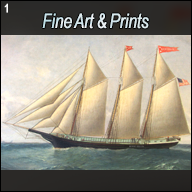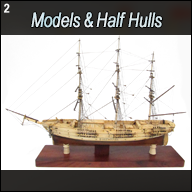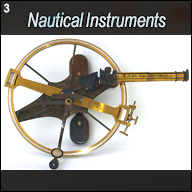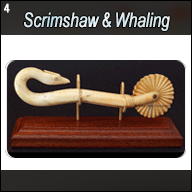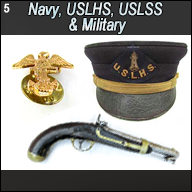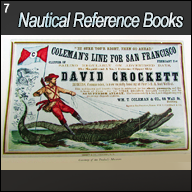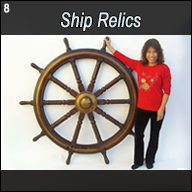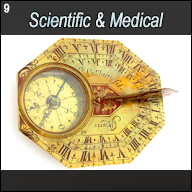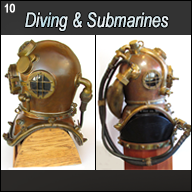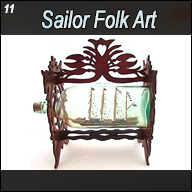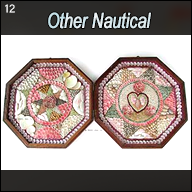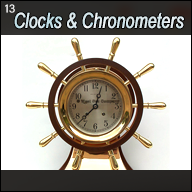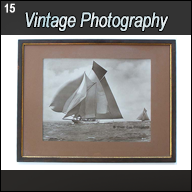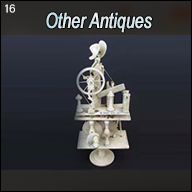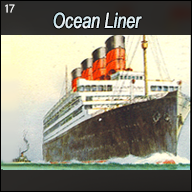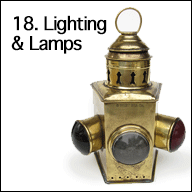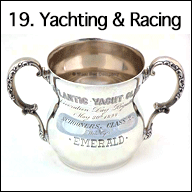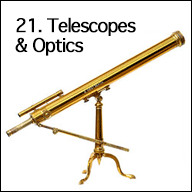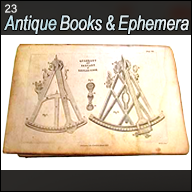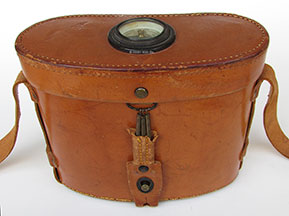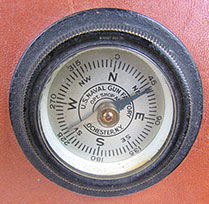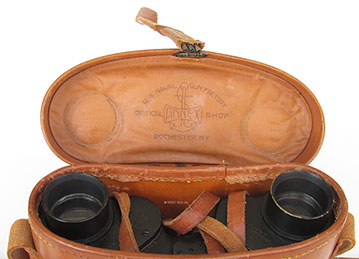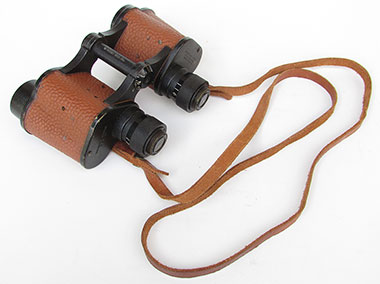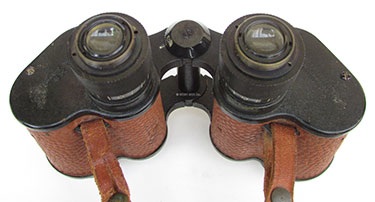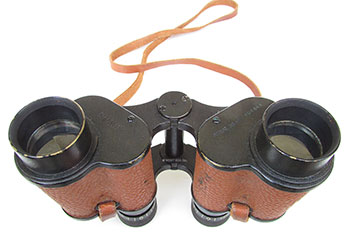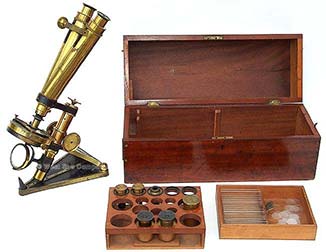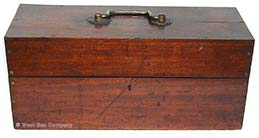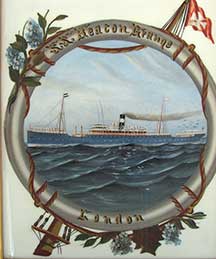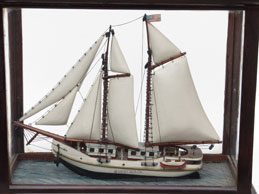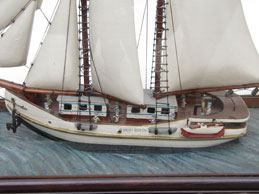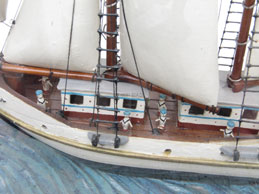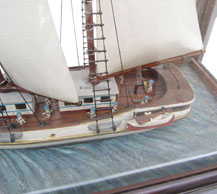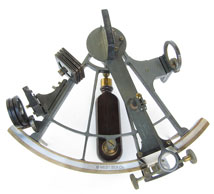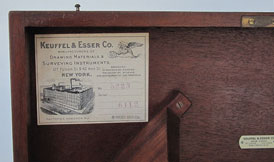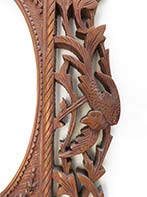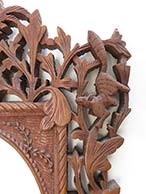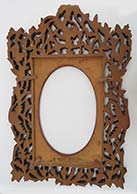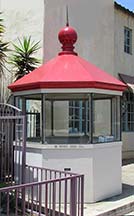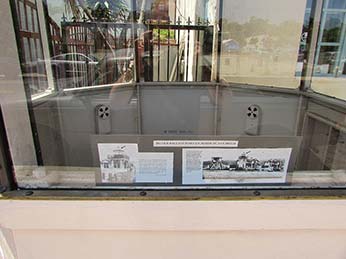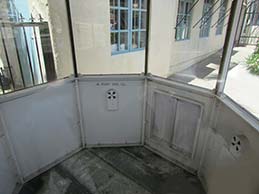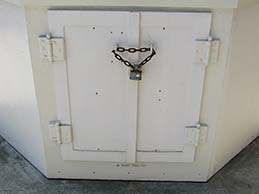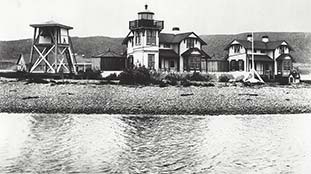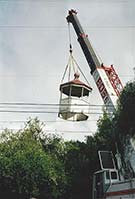24. BARGAIN SPECIALS:
Prices in U.S. Dollars are listed in GREEN.
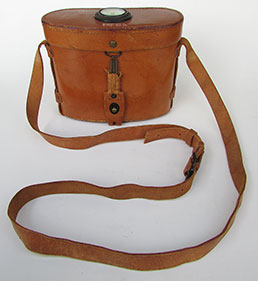
|
5.55 /21.90 EARLY NAVY BINOCULARS. Very scarce World War I vintage military binoculars made for the "Signal Corps U.S. Army" as stamped on the right side objective. On the ocular end it is marked "Military Stereo 6 x 30" on the left and "U.S. Naval Gun Factory Optical Shop Annex, Rochester, N.Y. U.S.A." These high quality prismatic binoculars are made of solid brass in a blackened finish with leather covering. Each ocular is knurled for individual focusing and is marked in diopeters + or -. The binoculars retain their original leather carrying strap and are complete with their very nice heavy leather case with spring-loaded closure. Of added interest and value is the very high quality compass in the lid, showing the cardinal and intercardinal points of the compass marked in 5 degree increments. It is signed "U.S Naval Gun Factory Optical Annex, Rochester, N.Y." The underside of the lid is impressed "U.S. NAVAL GUN FACTORY Optical Annex Shop Rochester, N.Y" with fouled anchor mark. The objective lenses measure 1 1/4 inches in diameter each. The binoculars are 6 ¼ inches wide and 4 ¾ inches long. The stout leather case is 7 ¼ inches wide by 5 ½ inches high. Excellent original optics and the compass is lively and accurate. The leather is in unusually nice condition considering it is over 100 years old. WAS $695 NOW! 495 |
CASE |
COMPASS |
GUN FACTORY |
BINOCULARS |
OCULARS |
OBJECTIVE |
MAKER |
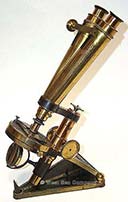
|
| 21.4 BINOCULAR MICROSCOPE. High grade 19th C. English microscope made for the American market, signed and serial numbered on the base "R. & J. Beck, London 7072." and further engraved on the main tube "J W QUEEN & Co. Agents, Philadelphia & New York." This finely crafted all brass compound microscope features adjustable Wenham-style binocular body tubes mounted on a sturdy base and stands 14 inches tall as shown. It is complete with a total of 4 objectives and 4 ocular lenses. It is housed in a lovely African mahogany box with brass furniture measuring 16 inches long. The lower till houses numerous glass slides while the upper section holds the additional optics, with 11 slots being empty including a separate slot for a light magnifier which is also missing. Of course the beauty of the innovation embodied in this microscope was the fact that the researcher could view a particular object with both eyes providing a clearer stereoscopic subject. This rare instrument is in excellent, untouched original condition with most of its original lacquered surfaces. It is functional and all adjustments operate smoothly and properly. A most handsome presentation! WAS $2195 NOW! 995 The body tubes of this microscope were designed by W. H. Wenham in 1861, and are adjustable by means of a knurled knob that controls a rack and pinion gear set. A triangular base supports the limb, which has an adjustable inclination angle through a series of holes in the limb that fit a tabbed hinge plate. Coarse focus is achieved through a set of knobs that move the inner pillar tube up and down through a rack gear set. The top of the pillar contains a fine focus knob. A circular stage contains a central aperture and has a slide carrier to assist in translating specimens during viewing. According to Turner, this form of the microscope stand was designed specifically to accommodate the Wenham binocular tube and was called "The Popular Microscope". Richard and Joseph Beck joined in a partnership as opticians at 31 Cornhill, London from 1867-1894. They were noted for their fine quality microscopes, and were admitted to the Microscopial Society of London. James W. Queen & Co. were in business as opticians at 48 Chestnut Street, Philadelphia from 1860-1893. |
WITH ACCESSORIES |
BOX |

|
7.90 SCIENTIFIC REFERENCE CALALOG. Trevor Philip & Sons, Ltd. "Of Heaven & Earth." 25th Anniversary printing of the firm's catalog. Hard cover with dust jacket, 51 pages. This renowned London dealer in the `90's and early 2000's offered some of the finest objects ever to be sold on the private market. Here in exquisite color detail he depicts and describes rare instruments, timepieces, telescopes, globes, folk carvings, important ship models and more. A delightful fully illustrated and well described raisonné. Was $39 NOW! FREE Just pay First Class postage. |
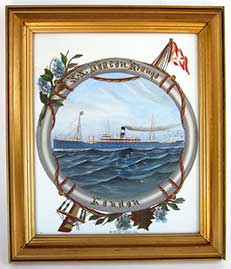
|
1.23 OIL PAINTING ON GLASS. J. Bell, English, late 19th century, oil on milkglass commemorative painting of the early steamer identified as “S.S. New England, Liverpool” in fancy lettering on the encircling life ring. This genuine ship’s portrait is very detailed and colorfully presented, “framed” within a classic old life ring, adorned with garlands and a ship’s mast with the vessel’s house flag. The portrait depicts the vessel flying the American flag from the foremast and the British ensign at the stern. The painting itself measures 9 ½ by 11 ½ inches sight. It is housed in its original carved walnut frame with gilt liner under old wavy glass secured with square nails. The frame measures 14 ¼ inches wide by 15 ¼ inches high. Outstanding original condition in all respects! A delightful presentation. Was $1395 NOW! 795 |
detail |
super detail |
back |
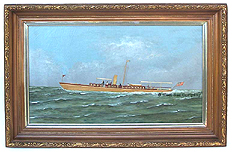
|
detail |
signature |
back |
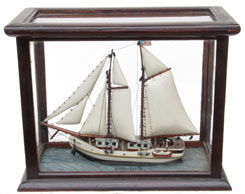
|
ship |
close up |
focsle |
stern close up |

|
sextant |
labels |
signature |

|
|
9.73 EARLY SURGICAL TOOL. Rare early 19th century surgeon's tool specifically designed for the extraction of tonsils from the throat of a hapless patient. This specialty tool was used prior to the advent of antiseptic and anesthetic conditions. One can only speculate how horrendous the procedure must have been! Known as a "Tonsil Guillotine," it consists of a fearsome sharp probe and two sliding steel orifices connected to a brass shaft terminating in a cross hatched ivory handle. Pulling the handle engages a sliding blade, the guillotine, which in theory would have sliced off the patient's tonsil once engaged by the probe and held by the orifice! Clever in its construction, this no less gruesome device bears decorative elements in its construction reminiscent of instruments from the Queen Ann period. It measures 10 inches long and is in excellent original functioning condition. Both the steel and brass components bear deep patination with surface oxidation, but no rust or corrosion. The ivory handle is sound with only minor staining (blood?). A very rare early surgical tool of museum quality. Was $1495 NOW! 695 Elizabeth Bennion in "Antique Medical Instruments," 1979, Sotheby Parke Bernet, London, pictures and describes a similar device with finger pieces on page 108. The photograph is captioned, "Tonsil guillotine, c. 1860, Museum of Historical Medicine, Copenhagen." The text, in part, reads, "Guillotines and forceps were listed in the catalogues from the early nineteenth century and were in two sizes, for adults and children. Tonsil-guillotines are easily recognizable by means of the two parallel sliding rings, one with cutting edge... Unlike many other instruments, the earlier examples tend to be lighter while those of a later date become complicated and cumbersome with elaborate finger pieces. Cased sets with various spare attachments were made c. 1860, but simple steel and brass guillotines have survived from at least ten years earlier." It is our belief that the example here is much earlier than 1850 and thus may in fact represent a prototype! |
closed |
open |
side |
handle |
handle detail |
shaft detail |
blade open |
blade detail |

|
|
12.25 CARVED CHINA TRADE FRAME. Lavishly-carved wooden picture frame produced for the Chinese export market during the mid-1800’s. It is carved from a single solid piece of valuable dealwood and was made for displaying the recently-invented prized photographic portrait. The intricate carving with floral motifs features a bird at the top flanked by two bushy-tailed squirrels on either side. Then midway down the frame are more birds on either side. The center consists of a rectangular “rope” border housing an oval opening decorated with delicate leafy branches and an even finer beaded boarder. The back of the frame has a 4 ¼ by 6 5/8 inch cut-out for mounting a photograph. To these ends it retains 4 small pivoting wooden clips on all four edges to secure the mount. The frame itself measures 11 ¼ inches tall overall by 7 ½ inches wide. Remarkably it remains preserved in almost perfect original condition with a beautiful original age patina! Was $495 NOW! 195 |
bird |
squirrel |
back |

|
perspective |
detail |
open |
label |
article |

|
detail |
signature |

|
AUTHENTIC LIGHTHOUSE. This is the ultimate! Here is an exceptional opportunity to own a very historic relic of America’s rich maritime heritage embodied in the original lamp room from the famous Ballast Point Lighthouse, which served its sentinel duties in the channel of San Diego Bay from 1890 until 1960. This incredibly well-preserved piece of history was built according to specifications laid out by the U.S. Lighthouse Service in 1885. A copy of the original specifications are included as are much printed references and photographs. Erected in 1890, the 5th Order lighthouse was a significant aid to navigation in conjunction with the Point Loma Lighthouse (1850) poised at the entrance to San Diego Bay. Ballast Point Light was situated further inside the massive bay on a point which jutted into the seaway which posed a hazard to shipping. 13 feet 10 inches high with a maximum width of 8 feet 8 inches. Weight approximately 5 tons. It will require a crane and a flat bed truck for transport. Over133 years old! Price Request On October 2, 1888, recognizing the need for a harbor light in the increasingly congested channel of San Diego Bay, Congress authorized $25,000 for the construction of a lighthouse to be built on Ballast Point. Fashioned in the late Victorian style, the entire structure took 3 months to build beginning in March 1890. The light was first lit on August 1st. It was a sister of the lights at San Luis Obispo and Table Bluff, south of Humboldt Bay. All were wood framed structures with attached living quarters. The ironwork for the lantern was forged in San Francisco and carried south to San Diego by ship. The French firm of Sautter, Lemmonier, & Cie. manufactured the Freznel lens for the Ballast Point Light in 1886. The fixed 5th Order lens was visible for a distance of at least 11 miles. |
LIGHTHOUSE BACK |
DETAIL BRASS WINDOW MOLDINGS AND GLASS |
INTERIOR |
ENTRY DOORS. THERE WAS NO INTERNAL ACCESS TO THE LAMP ROOM |
BALLAST POINT LIGHT STATION AS IT LOOKED IN 1903. NOTE THE BALLAST STONES ON THE BEACH AND THE DOG HOUSE ON THE RIGHT. THE OLD WHALING STATION IS IN THE BACKGROUND LEFT |
KEEPER STEVEN POZANAC AND THE 5TH ORDER FREZNEL LENS IN 1939. NOTICE THE FILTER INSIDE |
THE LIGHTHOUSE COMPLEX AS IT APPEARED IN THE 1940'S |
DISMANTLING THE LANTERN ROOM IN 1960 |
LIGHTHOUSE GINGERLY BEING REMOVED OVER HIGH TENSION POWER LINES |


